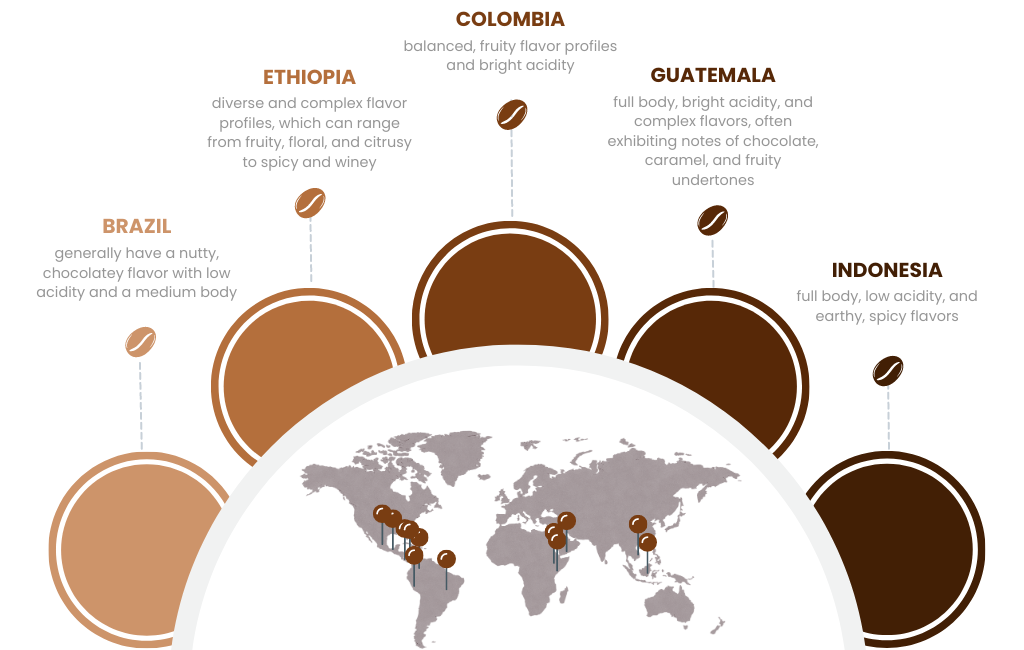Exploring the Diverse Flavors of Our Coffee Bean Selection
Brazil
Brazil is the world's largest coffee producer, responsible for roughly one-third of the global coffee output. The country is known for its diverse coffee flavor profiles, which vary depending on the region. Brazilian coffee beans generally have a nutty, chocolatey flavor with low acidity and a medium body. The most famous coffee-producing regions in Brazil are Minas Gerais, São Paulo, and Espírito Santo.
Interesting fact: Coffee was introduced to Brazil in the 18th century and has since become a major part of its culture and economy.
Ethiopia
Ethiopia is considered the birthplace of coffee, with a rich history dating back to the 9th century. Ethiopian coffee beans are known for their diverse and complex flavor profiles, which can range from fruity, floral, and citrusy to spicy and winey. The most famous coffee-producing regions in Ethiopia are Yirgacheffe, Sidamo, and Harrar.
Interesting fact: Ethiopian coffee is traditionally served during a coffee ceremony, an important social and cultural event in the country.
Guatemala
Guatemala is known for its high-quality Arabica coffee beans, grown in its high-altitude regions with rich volcanic soil. The country's coffee is characterized by its full body, bright acidity, and complex flavors, often exhibiting notes of chocolate, caramel, and fruity undertones. Key coffee-growing regions in Guatemala include Antigua, Huehuetenango, and Acatenango.
Interesting fact: The Guatemalan coffee industry has been recognized for its efforts in promoting sustainable farming practices and supporting local farmers through cooperatives and fair-trade initiatives.
Colombia
Colombian coffee is renowned for its high-quality Arabica beans, which are known for their balanced, fruity flavor profiles and bright acidity. The country's diverse geography, with the Andean mountains and various microclimates, plays a crucial role in the unique flavors of Colombian coffee. Key coffee-growing regions in Colombia include Antioquia, Huila, and Tolima.
Interesting fact: The Colombian Coffee Growers Federation's mascot, Juan Valdez, is an iconic symbol representing Colombian coffee worldwide.
Indonesia
Indonesia is an archipelago of over 17,000 islands, making its coffee production incredibly diverse. The country's coffee beans are known for their full body, low acidity, and earthy, spicy flavors. Some of the most famous Indonesian coffee beans come from Sumatra (Mandheling and Lintong), Java, and Sulawesi (Toraja).
Interesting fact: The island of Java, a significant coffee-producing region, has become synonymous with coffee, leading to the slang term "a cup of java."
Here are a few other notable coffee-producing countries that we absolutely love:
Kenya: Kenyan coffee is renowned for its bright acidity, fruity flavors (such as blackcurrant), and wine-like undertones, often grown at high altitudes near Mount Kenya.
Costa Rica: Costa Rican coffee is well-balanced, with medium body, bright acidity, and flavors ranging from citrus to tropical fruit, primarily produced in the Tarrazú region.
Yemen: Yemeni coffee is known for its intense, wine-like flavors, fruity and floral notes, and heavy body, with beans traditionally grown on terraced mountainsides in regions like Mocha.
Panama: Panamanian coffee, particularly from the Boquete region, offers a balanced, medium-bodied brew with floral and fruity notes, while the rare and sought-after Geisha varietal boasts a unique, delicate flavor profile.
Mexico: Mexican coffee is characterized by its light body and mild flavor, often featuring nutty or chocolate notes and a subtle acidity, with the Chiapas and Veracruz regions being major producers.
Peru: Peruvian coffee is known for its mild to medium body, bright acidity, and fruity or floral notes, often grown in high-altitude regions such as Chanchamayo and Cajamarca. The country has gained recognition for its focus on sustainable and fair-trade coffee production practices.
Vietnam: Vietnamese coffee has a strong, bold flavor profile with a higher caffeine content and a lower acidity compared to Arabica beans. The beans often have a nutty, chocolatey taste with a hint of bitterness. Key coffee-growing regions in Vietnam include the Central Highlands and Buon Ma Thuot.





